After Linkage and recombination part 1
We are going to learn from this part-
- Sex linkage
- Sex Linage in Drosophila
- Linked gene
- Synthetic gene
- X-linkage in Drosophila
- Linkage map
- Significance of linkage and crossing over
Best safe and secure cloud storage with password protection
Get Envato Elements, Prime Video, Hotstar and Netflix For Free
Best Money Earning Website 100$ Day
#1 Top ranking article submission website
Sex linkage
- Sex linkage refers to inheritance of a trait on the sex chromosomes, and thus its phenotypic expression depends on the sex of the organism.
- Sex linked genes are located on sex chromosomes, so inheritance pattern of the organism differs in male and female.
- Sex linked genes can be genetically linked.
- Sex linkage describes the sex-specific patterns of inheritance and presentation when a gene mutation (allele) is present on a sex chromosome (allosome) rather than a non-sex chromosome (autosome).
- In humans, these are termed X-linked recessive, X-linked dominant and Y-linked. The inheritance and presentation of all three differ depending on the sex of both the parent and the child.
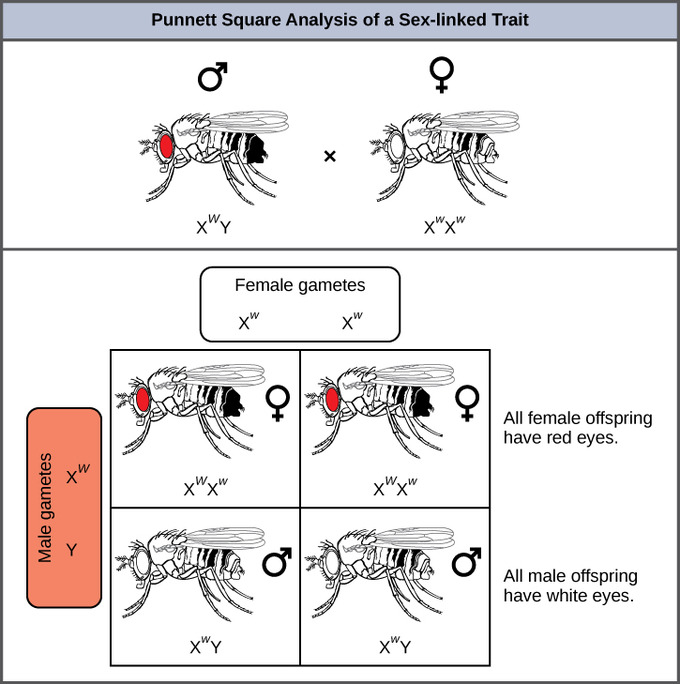
- Sex-linked diseases are passed down through families through one of the X or Y chromosomes. X and Y are sex chromosomes. Dominant inheritance occurs when an abnormal gene from one parent causes disease, even though the matching gene from the other parent is normal.
Sex linkage in Drosophilla
- Discovered by T.H. Morgan in 1910.
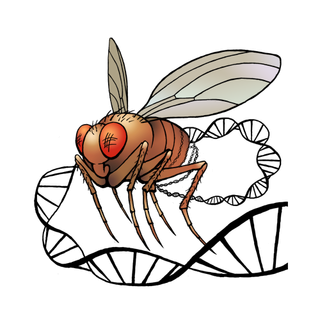
Drosophila Melanogaster, source here - He found a mutant white eyed male fly and used that in a series of experiment that showed that gene for eye color located in the X chromosome.
- Firstly, he crossed a white eyed male (mutant) with a red eyed female (wild type).
- He found, all F1 flies has red eyes. (1 female and 1 male)
- So, white eye is a recessive trait(mutant) and red eye genes are dominant over other (wild type).
- Next F1 were interbred that produce F2, where:
Red-eyed fly – 3470
White eyed fly- 782
-
- And only the males had white eye.
- The recessive number is too small to fit Mendelian ratios.
- All of the F2 white-eyed flies were male.
From that experiment Morgan hypothesized that eye color gene is located in X chromosome. In that case-
- Males are hemizygous, because there is no homologous gene on the Y.
- The original mutant male’s genotype was w/Y (hemizygous with recessive allele).
- Females may be homozygous or heterozygous, the wild type female in the original cross was w+/w+ (homozygous for red eyes)
- The F1 flies were w+/w (females) and w+/Y (males) (females all heterozygous, males hemizygous dominant)
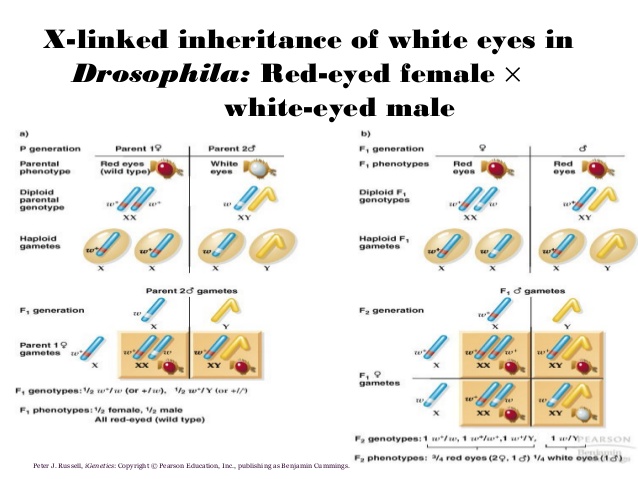
- Morgan’s hypothesis was confirmed by an experiment reciprocal to the original cross.
- A white eyed female (w/w) was crossed with a wild-type male(w+/Y). Results of the reciprocal cross:
1. All F1 females had red eyes (w+/w)
2. All F1 males had white eyes (w/Y) [Ratio 1:1]
- These F1 results are different from those in the original cross, where all the F1 had red eyes.
When the F1 from the reciprocal cross interbred,the F2 :
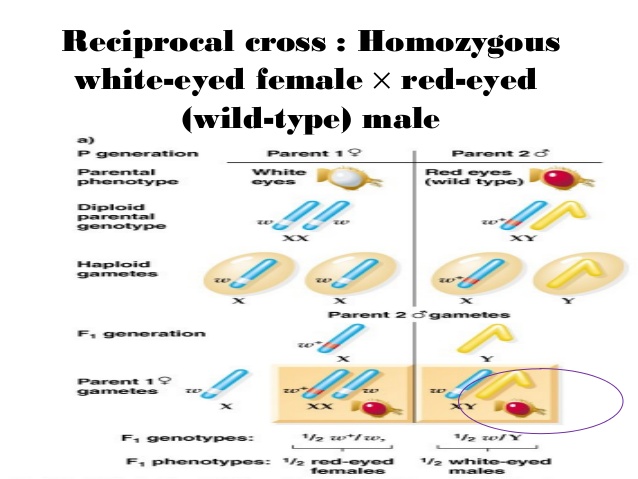
In reciprocal combination- the probability of hereditary factors passing as unit is low in comparison of original cross.
Then a result was observed in the test-cross (Cross between F1 generation of original cross and homozygous parent to see whether the F1 genotype homozygous or heterozygous), that was-
- Cross between red eyed female (heterozygous) and white eyed male (recessive parent).
- F1 result was,
-
-
- 2 Female – red eyed & white eyed
- 2 Male – red eyed & white eyed
- (ratio 1:1:1:1)
-
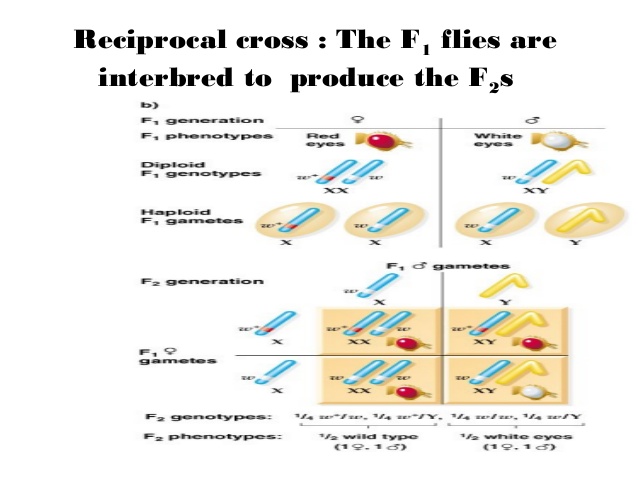
Morgan’s discovery of X-linked inheritance showed that when results of reciprocal crosses are different, and gene involved is likely to be X-linked (sex linked).
This was strong evidence that genes are located on chromosomes. Morgan received the 1933 Nobel Prize for Physiology or Medicine for this work.
Linked gene
- Linked genes are genes that are likely to be inherited together because they are physically close to one another on the same chromosome.
- When genes are close together on the same chromosome, they are said to be linked. That means the alleles, or gene versions, already together on one chromosome will be inherited as a unit more frequently than not.
- For example, genes for hair color and eye color are linked, so certain hair and eye colors tend to be inherited together, such as blonde hair with blue eyes and brown hair with brown eyes.
- During meiosis, chromosomes are recombined, resulting in gene swaps between homologous chromosomes.
- If genes are close together, It is impossible for linked genes to be on different chromosomes.
- If the genes are close together on the chromosome, the chances of being recombined are higher (the recombination frequency is very small than if they are far away from each other (then, the recombination frequency is 50%).
- If the recombination frequency is less than 50% we say the two loci are linked.
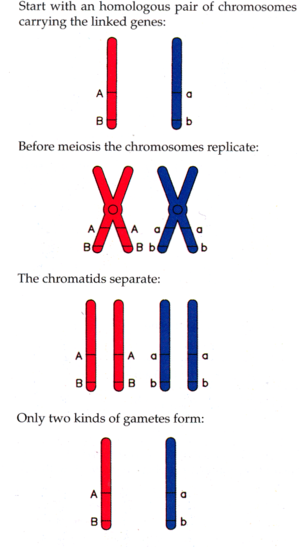
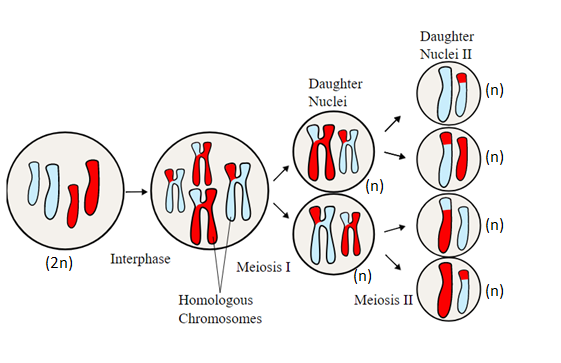

Synthetic gene
- Artificial gene synthesis, or gene synthesis, refers to a group of methods that are used in synthetic biology to construct and assemble genes from nucleotides.
- Unlike DNA synthesis in living cells, artificial gene synthesis does not require template DNA, allowing virtually any DNA sequence to be synthesized in the laboratory.
- Artificial gene synthesis could make use of novel nucleo-basepairs (unnatural base pairs) in the future.
- Gene synthesis enables creation and modification of genetic sequences at an unprecedented pace, offering enormous potential for new biological functionality but also increasing the need for.
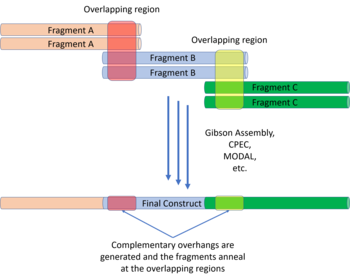
Linkage map
- A linkage map(also known as a genetic map) is a table for a species or experimental population that shows the position of its known genes or genetic markers relative to each other in terms of recombination frequency, rather than a specific physical distance along each chromosome.
- Genetic mapping a way to identify exactly which chromosome has which gene and exactly pinpointing where that gene lies on that particular chromosome. Mapping also acts as a method in determining which gene is most likely recombine based on the distance between two genes.
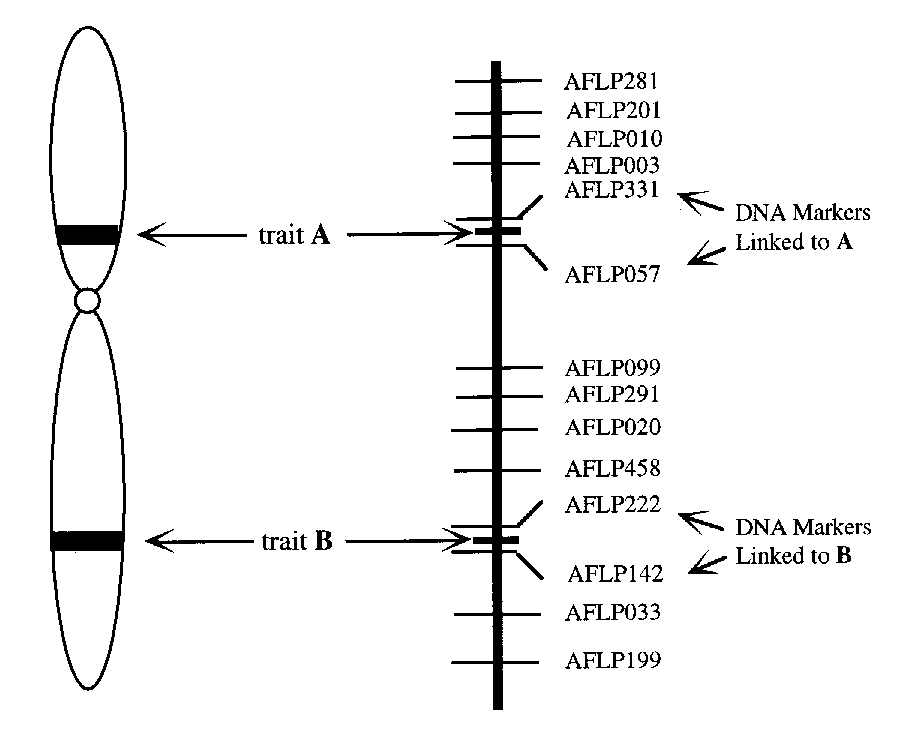
Genetic linkage in X linked genes
- When a gene is present on the X chromosome, but not on the Y chromosome, it is said to be X-linked. X-linked genes have different inheritance patterns than genes on non-sex chromosomes (autosomes). That’s because these genes are present in different copy numbers in males and female.
- Since a female has two X chromosomes, she will have two copies of each X-linked gene.
- For instance, in the fruit fly Drosophila(which, like humans, has XX females and XY males), there is a eye color gene called white that’s found on the X chromosome, and a female fly will have two copies of this gene.
- A male has different genotype possibilities than a female. Since he has only one X chromosome (paired with a Y), he will have only one copy of any X-linked genes.
- We can see how sex linkage affects inheritance patterns by considering a cross between two flies, a white-eyed female and a red-eyed male.
- If this gene were on a non-sex chromosome, or autosome, we would expect all of the offspring to be red-eyed, because the red allele is dominant to the white allele. What we actually see is the following (single point cross):
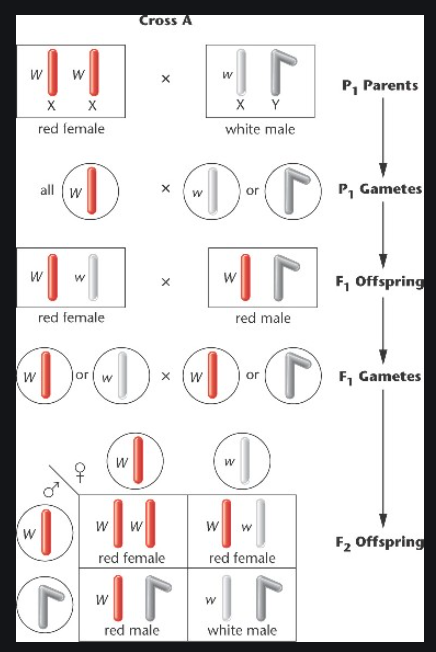
- In F1 ,
-
- All of the female offspring acquire a dominant W allele from the mother and a recessive w allele from the father, and are therefore heterozygous dominant with red eye color.
- All of the male offspring acquire a dominant W allele from the mother and a Y chromosome from the father. and are therefore hemizygous recessive with white eye color.
- In F2 ,
- All females are red eyed (both Homozygous WW and heterozygous Ww female can be found)
- And Males are- red eyed heterozygous Ww : white eyed hemizygous recessive wY.
Morgan’s experimental crosses of white-eye and miniature-wing variants of Drosophila
- both the white eye gene and the gene for miniature wings are on the fly X chromosome
- female white eyed, miniature winged flies where crossed with wild type males (wm/wm and w+m+/Y)
- In the F1 all mails wear white eyed with miniature wings (wm/Y) and all females were wildtype for both eye color and wings size (w+m+ /wm)
- F1 interbreeding was then undertaken (this action is the equivalent of a test cross, as we know the genotypes)
- In the F2, the most frequent phenotypes for both sexes were the phenotypes of the parents in the original cross (white eyes with miniature wings, and red eyes with normal wings)
- Nonparental phenotypes (white eyes with normal wings or red eyes with miniature wings) occurred in about 37% of the F2 flies. This is statistically well below the 50% prediction rate for independent assortment, indicating that non parental flies result from the recombination of linked genes.

From his studies, Morgan proposed that,
- during meiosis, alleles of some gene assort together because they are near each other on the same chromosome
- Recombination occurs when genes are exchanged between the X chromosomes of the F1 females (it must occur in the female population because males don’t have 2 homologous X chromosomes)
Repeated studies produced similar results.
Significance of Linkage and Crossing over
Significance of linkage
- Linkage does not permit the breeders to bring the desirable characters in one variety. For this reason, plant and animal breeders find it difficult to combine various characters.
- Linkage reduces the chance of recombination of genes and thus, helps to hold parental characteristics together. It thus helps organism to maintain its parental, racial and other characters.
- As soon as a chromosomal location for a disease phenotype has been established, genetic linkage analysis helps determine whether the disease phenotype is only caused by mutation in a single gene or mutations in other genes can give rise to an identical or similar phenotype.
Significance of crossing over
- This process provides an inexhaustible store of genetic variability in sexually reproducing organisms.
- Useful recombinations are used by the plant and animal breeders. Breeders try to break up the linkages by crossing-over to get combinations of useful traits in the progeny.
- This process produces a new combination of genes (recombination).
Reference
- Book- Principles of Genetics by D. Peter Snustad and Michael J. Simmons.
- From class lecture by Dr. Rita Sarah Borna Ma’am, Assistant Professor, Department of Botany, University of Dhaka.
- Genetic Linkage From Wikipedia
Revised by
- Khaleda Akter Shompa on 13th July, 2021.
 Plantlet The Blogging Platform of Department of Botany, University of Dhaka
Plantlet The Blogging Platform of Department of Botany, University of Dhaka
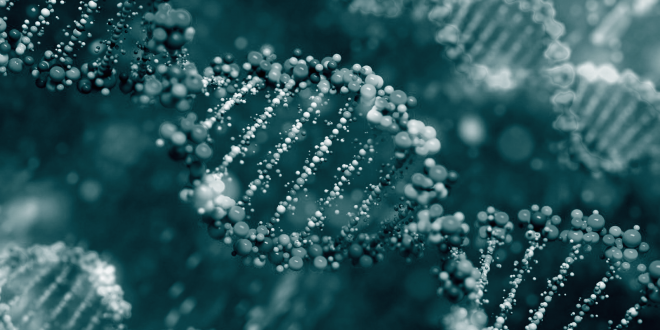





Your point of view caught my eye and was very interesting. Thanks. I have a question for you.